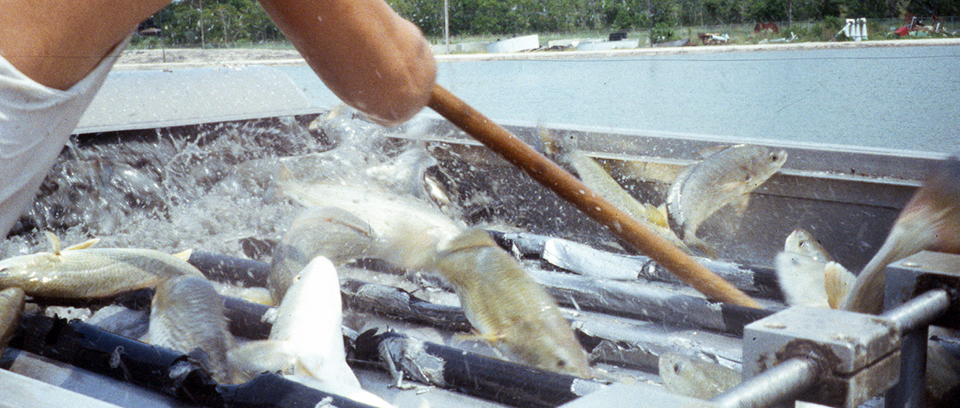No notable differences among the parameters tested

A rapid expansion in aquafeed production has paralleled the global expansion of aquaculture production systems, often relying on fishmeal as a source of high-quality protein, highly unsaturated fatty acids, minerals, vitamins, and attractants. Given the finite supply of fishmeal and other marine protein sources, alternative ingredients are needed for production diets for marine fish.
The red drum (Sciaenops ocellatus) is one of the few warmwater marine fish that is commercially cultured in North America and Asia. Consequently, considerable research has been conducted with respect to its nutritional requirements and the use of nonmarine protein sources in its manufactured feeds.
Fishmeal replacement
The replacement of fishmeal with soybean meal in feeds for red drum juveniles has had varying degrees of success. Although various nutritional factors could be implicated, the poor fish performance was often due to reduced feed palatability when fishmeal and other marine protein sources were removed. A similarly poor response was found when using low levels of meat and bone meals in practical diets.
Recently, the University of Texas at Austin Marine Science Institute in Port Aransas, Texas, USA found that poultry byproduct meal can be used as a substitute for fishmeal in diets for juvenile red drum. However, the majority of feed inputs, and hence fishmeal use, occurs during the grow-out stage of production.
Hence, it is important to develop nutritional requirements and feed formulations for large fish. Recent research at the Marine Science Institute was designed to evaluate solvent-extracted soybean meal as a replacement for fishmeal in practical diets with 20 percent poultry byproduct meal.
Trial setup
Diets with 40, 30, 20, 10 and 5 percent fishmeal were designed to contain 44 percent protein and 10 percent lipid. A sixth diet was also formulated to contain 5 percent fishmeal with krill hydrolysate added at 1 percent of the diet as a palatability enhancement.
The test diets were offered to juvenile red drum of 179-gram mean initial weight over a 14-week growth trial. The trial was conducted in a semi-closed recirculating system designed to maintain suitable environmental parameters for the species: 29.6 ppt salinity, 27.7 degrees-C temperature, and 6.1 milligrams per liter dissolved oxygen.
Results
At the end of the trial, the red drum reached a marketable size of about 620 grams, were in good health, and had survival over 95 percent. Mean values for final weight, percent gain, feed efficiency and protein-conversion efficiency are presented in Table 1.
Davis, Response of red drum (initial weight 179 g) offered test diets, Table 1
| Mean Weight (g) | Weight Gain (%) | Feed Efficiency (%) | Protein Conversion Efficiency (%) |
|---|
Mean Weight (g) | Weight Gain (%) | Feed Efficiency (%) | Protein Conversion Efficiency (%) | |
|---|---|---|---|---|
| Average, All Diets | 620.1 | 246.4 | 65.2 | 28.9 |
Protein conversion efficiency = dry protein gain x 100/dry protein offered
Table 1. Response of red drum (initial weight 179 g) offered test diets with varying levels of fishmeal and a low-fishmeal diet with krill hydrolysates.
In general, there were no notable differences among the parameters tested. The results indicated the low-fishmeal diets were acceptable in terms of nutritional quality and palatability to the red drum.
Palatability
The replacement of marine protein sources often changes the nutritional profile of the diet and also affects palatability. The trial diets were supplemented with crystalline methionine and phosphorus to maintain minimal levels of these nutrients. However, it is presumed the presence of poultry byproduct meal in the diets maintained the palatability.
To evaluate palatability reduction in the diets, the low-fishmeal feed was also supplemented with 1 percent (dry weight) krill hydrolysate. Krill meal is often used to enhance palatability and for feed training fish. The krill supplementation did not appear to influence growth. Therefore, since there was no apparent reduction in growth or feed consumption as fishmeal was replaced with soybean meal, the addition of an attractant probably was not necessary.
Conclusion
Research at the Marine Science Institute has demonstrated that fishmeal can be replaced with other nonmarine protein sources, as long as the nutritional value and palatability of the diet are maintained. Fishmeal replacement with soybean meal and poultry byproduct meal could result in significant cost savings without compromising growth and feed-conversion efficiencies, and reduce dependence on limited marine resources.
(Editor’s Note: This article was originally published in the April 2002 print edition of the Global Aquaculture Advocate.)
Now that you've finished reading the article ...
… we hope you’ll consider supporting our mission to document the evolution of the global aquaculture industry and share our vast network of contributors’ expansive knowledge every week.
By becoming a Global Seafood Alliance member, you’re ensuring that all of the pre-competitive work we do through member benefits, resources and events can continue. Individual membership costs just $50 a year. GSA individual and corporate members receive complimentary access to a series of GOAL virtual events beginning in April. Join now.
Not a GSA member? Join us.
Author
-
D. Allen Davis, Ph.D.
Department of Fisheries and Allied Aquacultures
204 Swingle Hall
Auburn University
Auburn, Alabama 36849-5419 USA
Tagged With
Related Posts

Responsibility
Assessing the carbon footprint of aquaculture
A carbon footprint is an estimate of the total carbon emissions resulting from the production, use and disposal of a product or service. Carbon footprints for aquaculture products result mainly from the use of manufactured feed and mechanical aeration.

Intelligence
Byproduct utilization for increased profitability, part 4
Protein hydrolysates can be produced by acid, base or enzymatic hydrolysis processes. Acid hydrolysis produces salt that makes the product unsuitable for food and destroys some essential amino acids. An optimum process for one fish or shellfish by-product may not be optimum for another.

Health & Welfare
Dietary strategies for disease management in the post-antibiotic era
Policies to limit antibiotic use spurred interest in alternative strategies, such as dietary supplementation with immunostimulants and other compounds.

Aquafeeds
F3 Prize: Putting money where fish’s mouths are
Interest is growing in a two-year-long competition aimed at driving innovation in the aquafeed sector. The F3 prize for a demonstrably fish-free feed comes with a cash reward, and possibly a glimpse at the future.


